Quick Response Flood Control Kit Program
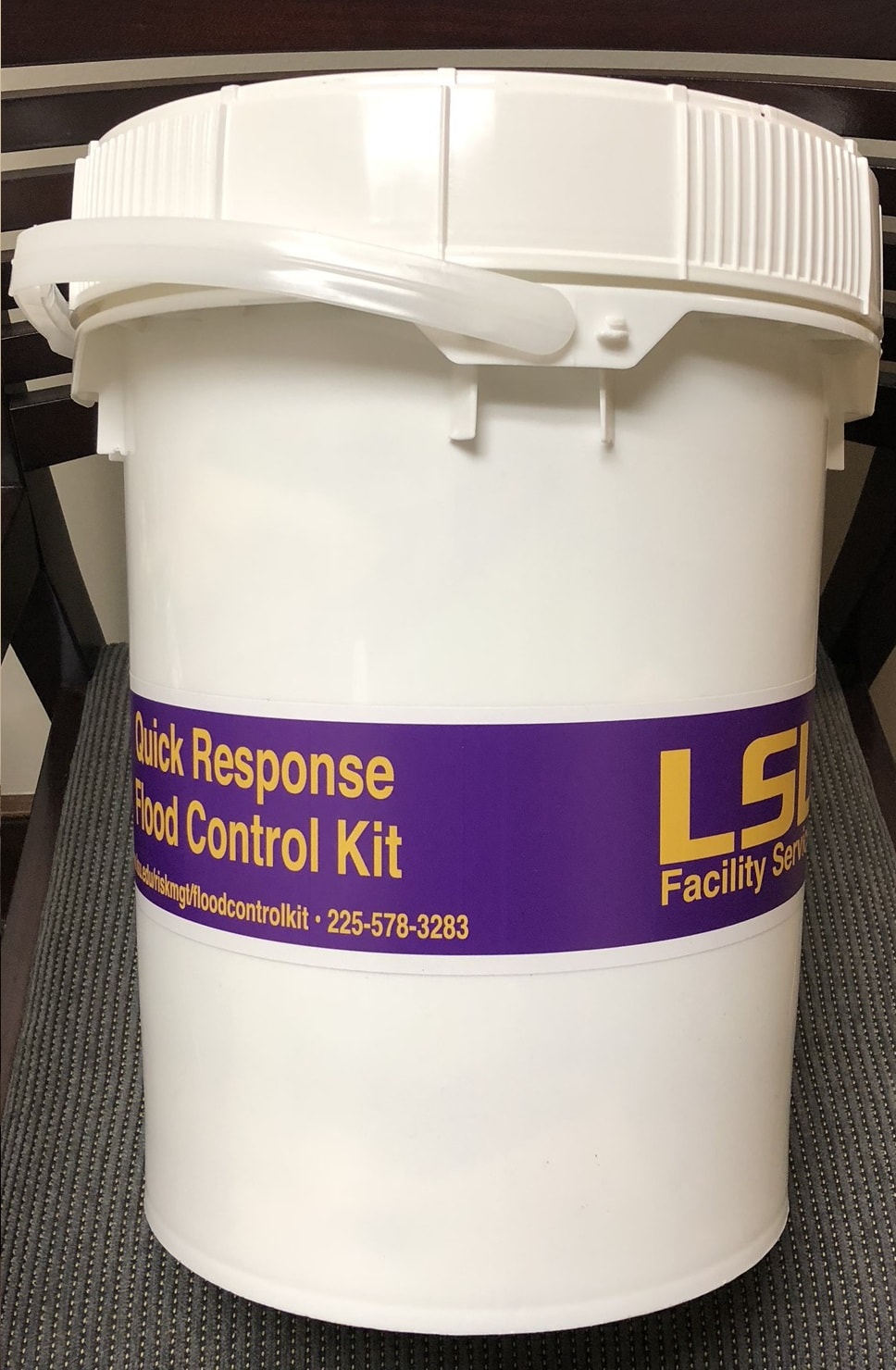
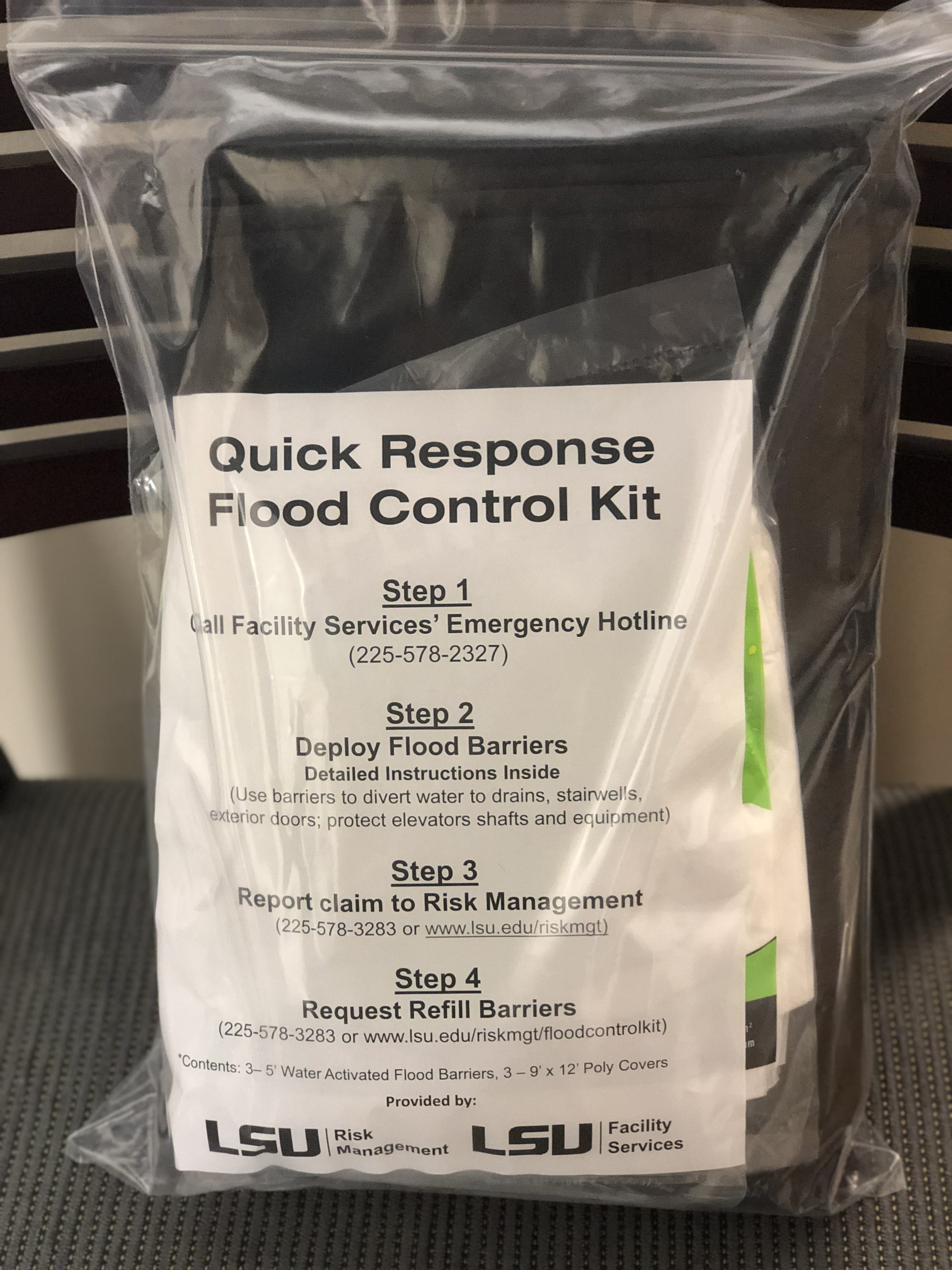
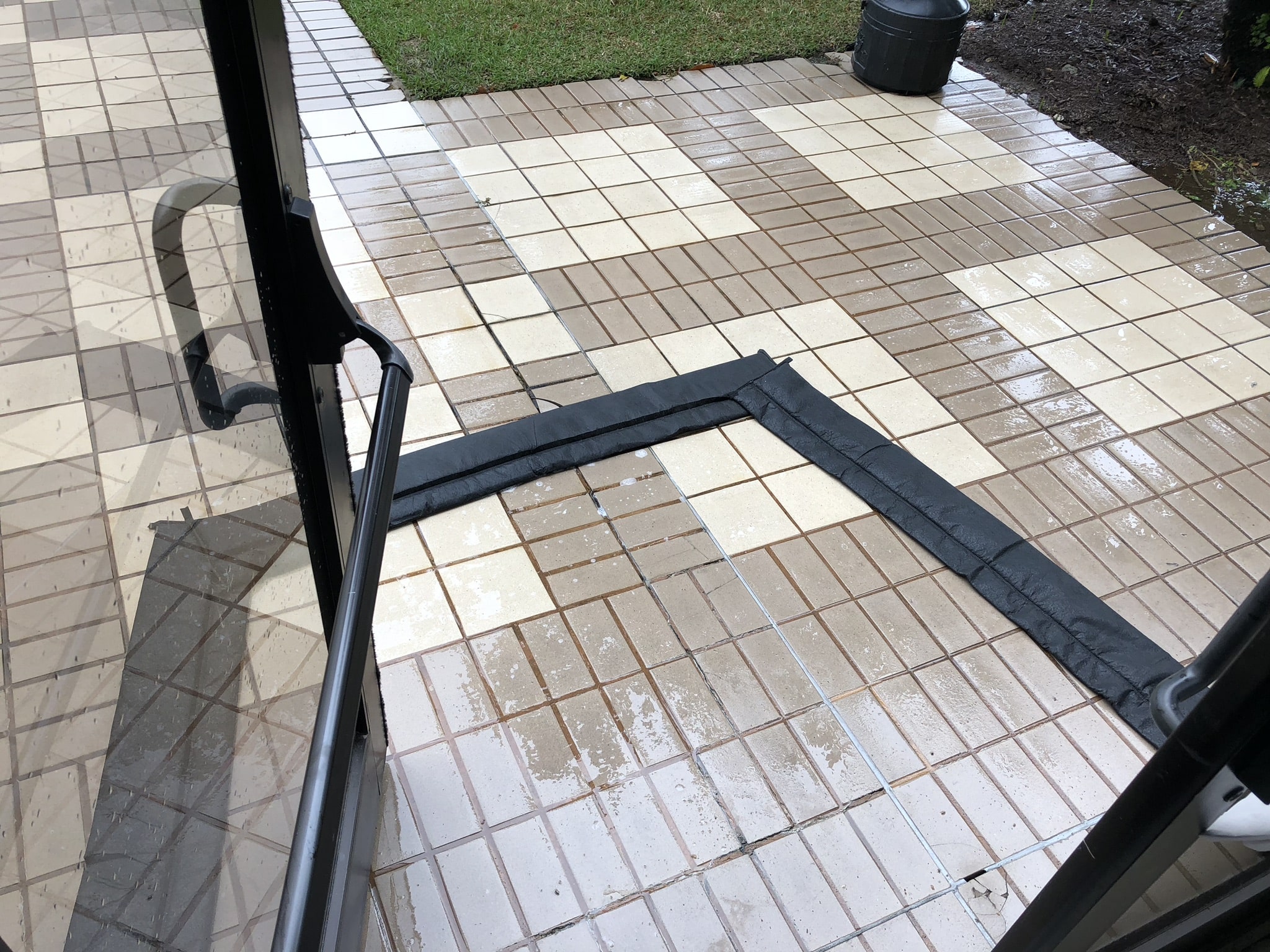
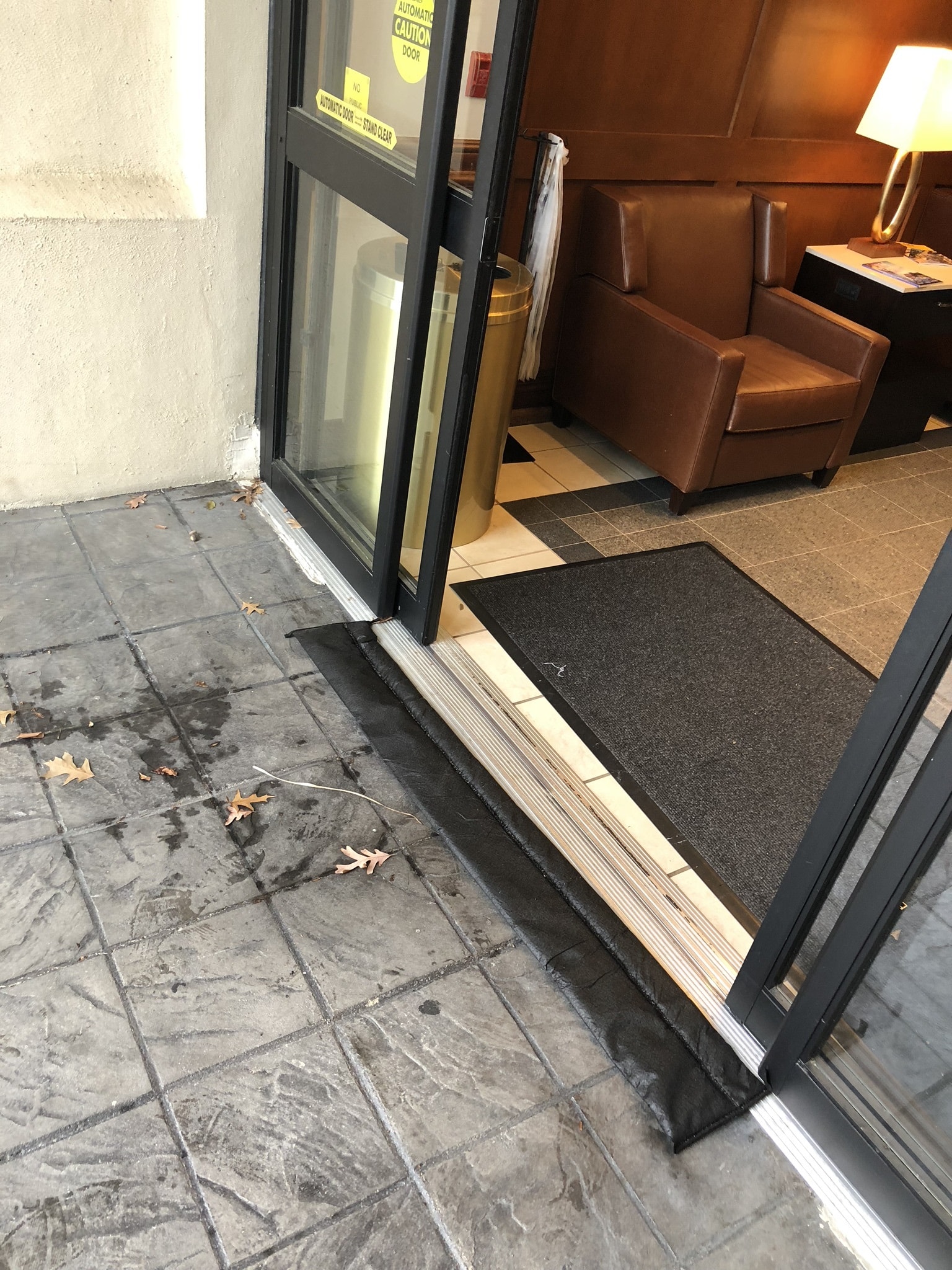
The information below will answer many of your questions.
In an effort to mitigate the impact of water damage to LSU’s operations and property, Risk Management, in partnership with Facility Services, has created the Quick Response Flood Control Kit Program. This program will provide departments and our custodian team with an innovative and easy to use sand-less flood barrier system to deploy during a flash flood or other water damage event. When deployed in doorways, around water entry points, and high value contents, the flood barrier system will hold back water to limit the impacted area while Facility Services responds to the event. For any loss when the flood barriers are deployed , Risk Management will waive the department’s $1,000 deductible.
The kits will consist of water activated flood barriers (5ft) and polyethylene sheets (9x12ft). The flood kits are available in two sizes: large (five gallon buckets) and small (two gallon bags). The large kits will hold eight flood barriers and four polyethylene sheets. The large kit availability is prioritized for high risk areas, such as basements or locations with a history of water damage incurred through flooding. The small kits will hold three flood barriers and three polyethylene sheets.
In order to use the barriers, please remove them from the package, apply water to the barrier to activate the gel, then place in an area to prevent water damage / intrusion. When placed, the water should be touching the large side of the barrier to prevent the barrier from rolling over as pictured above in the header photos.
Poly Tarps should be draped over equipment to prevent damage from the roof for leaks. Place the poly tarp over the equipment and tape it down if tape is available.
Please watch the following videos for more info on how to use Quick Dam Flood Barriers:
- Quick Dam Introduction - This video highlights the innovative design of the Quick Dam Floor Barrier
- Quick Dam in Use - This video shows Flood Barriers being used to expend water
- Quick Dam vs. Sand Bags - This video highlights why Quick Dam Flood Barriers are a better tool than Sandbags
There is no cost to participate in the Quick Response Flood Control Kit Program, however availability will be limited to funding. Flood Kit refills will be provided when the flood barriers are deployed for a loss reported to Risk Management. Departments may also purchase refills or additional flood barriers for their Quick Response Flood Kit via Workday, utilizing the Grainger Master Contract - Item Number that Risk Management purchased is 49UV21.
In the event that you use your Flood Control Kit, please email Risk Management for a refill. Do not throw out the 5 gallon buckets or used barriers (5' black barriers). Risk Management or Facility Services will dispose of these after use or recycle them if possible.
We would love to hear about your Flood Control Kit success story, please email us and share how it went.
- Do - Activate the barriers with water and place on the ground. Fix the barriers in a way that there will be minimal leak points.
- Do Not - Place the barrier and hope rain will activate the gel. In some cases this works, but the barrier may move as it fills with water and can then have leaks or runways for water to come in side.
-
Place barriers in front of doorways as pictured above in the header images. You can corral the water if the door opens outward or place the barrier flat if the door opens inward.
-
If there is a large area of water, combine multiple barriers end to end to corral the water as pictured above in the header images.
Coming Soon! Flood Control Kit success story. Don't forget that we would love to hear about your Flood Control Kit success story, please email us and share how it went.
| Question | Answer |
|---|---|
| How can I get Quick Response Flood Kit for my department? | Please complete the form below on this web page or contact Risk Management to request further information about the Flood Control Kit Program. |
| How much does a Quick Response Flood Kit cost? | Flood Control Kits are free to departments while supplies last. |
| How do I refill my Quick Response Flood Kit once used? | Please contact the Office of Risk Management. |
| How do they work? | Quick Dams Flood Barriers contain a super absorbent polymer (similar to what’s inside baby diapers) that react and swell on contact with water. Once activated (typically 5 minutes), the water is contained as a gel within the fabric, thus acting as a barrier. |
| I see white gel, what do I do? | White gel will tend to come through the barrier at the seams, especially during the first use. This means the barrier is doing its job! The white gel is not harmful and does not indicate that the flood barrier is defective. The gelled water will wash away with water, degrade over time & is non toxic & nonhazardous. |
| How do you activate a barrier? | In order to activate a flood barrier, you need to get it wet. This can be from sink water, a water hose or any other water source. We suggest, if possible, activate the barriers before placing to prevent the barrier from moving. |
| Will a barrier prevent salt water? | No, Quick Dams do not work with salt water, calcium, lime or chlorine. There is a chemical reaction that causes the absorbed water to be released back out, making them not effective as a barrier & must be thrown away. |
| The same area keeps flooding. Can I leave my barriers there? |
Depending on your situation, you may pre-activate them or let the weather activate them. Quick Dams can be placed in position and wait for water to arrive. If a current of water is expected, partially activating them is recommended so that they don’t float away. After they barriers are wet, they will slowly dry up and become flat again. With the high level of humidity in our area and relatively constant rain, you will not see the barriers dry up completely if left outside, but they will shrink down in size. |
| How should I position Quick Dam Flood Barriers? |
Flood Barriers contain a wedge to prevent them from rolling. When laying in position, be sure to place the “mini channel” away from flooding water. This will assure that as it grows, it acts as a wedge to secure in position. Ideally, place Quick Dams outdoors in the path of problem water & divert it before it becomes a problem. If the water source is from an internal source, the best location is to place the Quick Dams around the source or in doorways. You can also stack barriers if the water level is rising over the height of only one barrier. If an area is larger than 5', you can put the barriers end to end to prevent a larger area. Barriers can be stacked up to 3 barriers high in a brick formation. Any higher than this will require a pyramid foundation. Stacking may prevent water, but also causes the barriers to be unstable if you stack them too high. |
| How long do the barriers last? |
|
| Can I re-use the barriers? |
Yes, you can re-use them. Once activated, Quick Dams will remain active until the water evaporates, typically taking several weeks for complete evaporation. If left in position, they will shrink while evaporating and grow when re-exposed to water. Be sure to store your activated Quick Dams, so they do not cause a tripping hazard. |
| My barrier is shrinking, why? | As the water evaporates, they will get smaller. If complete evaporation is desired, store Quick Dams in a dry environment , like a garage or shed. Over several weeks, Quick Dams will shrink & become crunchy & ready to store away. Once re-exposed to water, they will absorb & swell again. |
| What do I do after use? |
Quick Dams are environmentally friendly and can be disposed of in the trash. Polymer contents will degrade with UV exposure, pressure and time, leaving an empty pouch that can be thrown in the trash. Contents will be VERY slippery, if leaks occur so replace Quick Dams before they degrade and keep degrading activated Quick Dams off of walkways to prevent slip & fall accidents. Feel free to reach out to Risk Management for disposal. |
| Are barriers for outdoor or indoor use? | Barriers can be used indoors and outdoors. They will be moist, so be careful when leaving them on floors that are susceptible to water damage or could cause a slipping hazard. |
| Will a barrier roll away? |
|
| The barrier is leaking water, what do I do? |
Check that the surface is even and that the barrier has no gaps under it where the water is seeping in. Quick Dams will absorb, swell and gel water, creating a barrier. If the surface is uneven, seepage may occur. If large amounts of water are expected, double layers or stacking & building a wall may be necessary to prevent leakage. Quick Dams are not a solution for every application. |
| Will barriers mold? | Quick Dams alone will not grow mold, but if they are activated with contaminated water, then there is a possibility, so storing them outdoors to dry out is recommended. |
| Do the barriers smell? | No, not on their own. Although they will absorb an odor if it is present in the fluid absorbed, and this may cause it to split open. |
| How long does it take to dry out a barrier? | Time will vary based on weather conditions. The hotter, drier areas will take a month or so, & more humid, cooler areas may take 3 months. They will be left crunchy. During drying- do NOT leave them in the sun, as this causes them to degrade & not reactivate later. |
Please complete the form below to request Flood Control Kit(s):
If assistance is needed to complete the below form, contact LSU Risk Management at 225-578-3283
If more assistance is needed please email Risk Management.
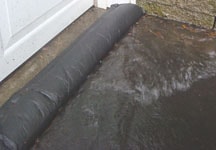 Quick Dam Flood Barriers have an extra wedge stitched along its length that acts as
a wedge & prevents them from rolling away. This wedge should be opposite of the water.
Quick Dam Flood Barriers have an extra wedge stitched along its length that acts as
a wedge & prevents them from rolling away. This wedge should be opposite of the water.